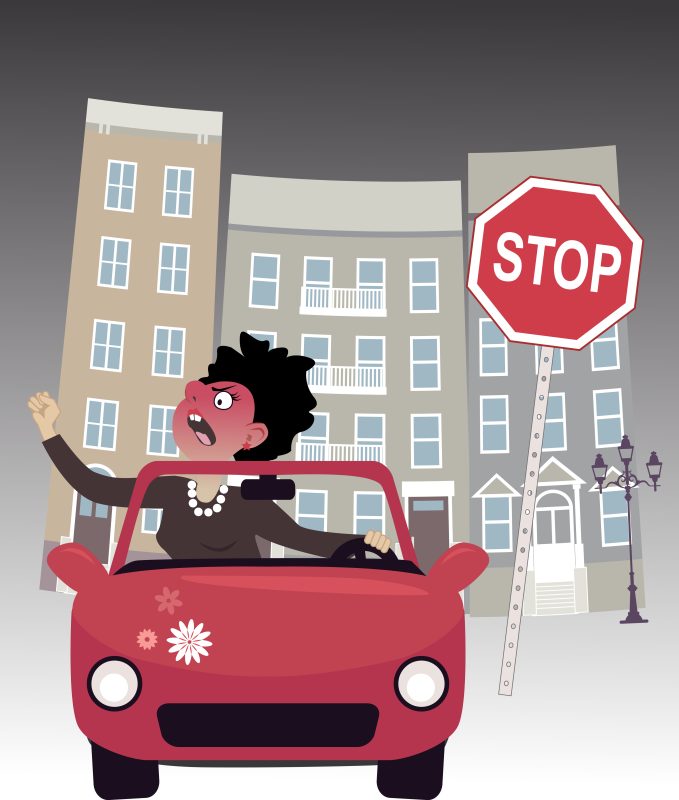After driving for 40 years in a country where traffic rules and regulations are strictly enforced and observed, culminating in a predominantly safe and positive driving culture, adjusting to driving in Amman has been quite the endeavor for this new resident.
The beautiful country of Jordan has been my home since late 2019; the highlights of some of my favorite days involve leisurely driving through the tranquil scenery of Zai and Ajloun and grabbing karak tea on the way.
Returning to drive on the roads of Amman is most stressful. I can almost see my blood pressure rising as we approach the city. A Jordanian friend stopped driving in the capital altogether because it led to high blood pressure. He now relies on Uber.
I’ve observed that motorists have the same driving style regardless of their backgrounds – often ignoring traffic laws to get from point A to point B, never mind driving etiquette.
When I express my frustration to associates, I’m told: “Welcome to Jordan.” But this mindset contributes to the persistence of a tragic condition necessitating considerable intervention, a change of mindset, and the driving culture.
A Ministry of Health 2018 study revealed that traffic accidents ranked the fourth leading cause of death among Jordanians and 36th globally in terms of traffic-related deaths. In 2020, the Public Security Directorate’s Traffic Institute reported that Jordan has one of the highest rates of traffic accidents in the region, year on year. Among those injured or killed in road crashes, individuals between 18 and 35 constituted 47.5%, and children under 18 had the highest number of severe injuries at 34.2%.
Traffic laws save lives, and traffic-related deaths are preventable. No day or night in any individual’s life should end in a self-inflicted tragedy resulting from negligence or willful violation of the regulations.
Driving Behavior
The driving behavior frequently observed on the roads leans toward aggression. To further explain, it is often seemingly deliberate behavior arising from impatience, annoyance, and anger, increasing the risk of collision in an attempt to save just a maximum of a minute or two.
For instance, if you signal your intention to turn, the driver behind you may accelerate to go ahead of you. This behavior is puzzling, as signaling is supposed to indicate your intentions to other motorists. Yet, some drivers seem to be on a mission, approaching others like an Exocet missile.
Many young people stay up late, struggle to wake up on time for work, and find themselves in a rush to get to the office, leading to disruptive driving. Most youths believe they are superior drivers trying to maneuver through bumper-to-bumper traffic but only compounding the issues. The responsible, more experienced drivers tend to leave early or stay 30 minutes longer at work to avoid congestion.

Angry driving is a common symptom, you get tailgated in narrow streets when going home, yelling, staring, gesturing, and much more.
Innovation in Dangerous Driving
Certain drivers display remarkable innovation in dangerous driving, thinking that being fast and reckless demonstrates skilful driving. I was once zoomed home from Aqaba by a 26-year-old in his brand-new pick-up truck trying to impress me by going as fast as possible…speeding, then braking hard when speed bumps suddenly appeared in the middle of the highway, then trying to overtake slow-moving vehicles at very high speeds within inches from the road divider. Did he always have 100% control? No, he did not. Was the pick-up truck stable? No, it is not built for high speeds. Its high ground clearance makes it prone to instability, just like SUVs. No stability at high speeds and sudden moves/turns. Reckless endangerment of oneself and others is neither cool nor a real test of toughness.
The nightmare-like experience, unfortunately, didn’t end there. He tried to outmaneuver a BMW X5 on Airport Road, a vehicle you don’t mess with, especially in a pick-up truck. Its road handling is fantastic. My wife had one, and I could not keep up with her in my Range Rover Sport. All he saw was the dust left behind by the X5 driver, who knew how to handle his vehicle. In the end, we got home safely; needless to say, it took a while for the blood to return to my face.
Everyone is In a Hurry to Get Somewhere
The violations begin as you attempt to leave the parking area of your building, a one-way street that only goes right; naturally, you will look left for oncoming cars. Not me…I learned to look right first to pre-empt a driver coming at high speed in the opposite direction. I had three near misses in the last two months. Two of those drivers were wearing suits and drove luxury vehicles. Unfortunately, the refined exterior did not translate into their treatment of other motorists on the road. In the three incidents, none of them even looked at me; they sped on without a gesture of apology, as if my car and I were translucent. Every second building in my area has men and women exiting their basement parking in the opposite direction of oncoming traffic on a one-way street to save a 30-second drive to the main road in the right manner.
Honking Fascination
For an individual who refrains from honking except in absolute emergencies and considers it a symptom of aggressive driving behaviour, honking in Amman is a standard means of communication between drivers. It’s almost as if they are conversing with each other. For instance, it’s typical for drivers to stop well ahead of a traffic light and keep checking their phones until the car behind them honks to signal: “move already.” Sometimes the honking starts as soon as the light turns orange. I’ve realized this is standard practice, so if I’m the second car at the light, I’ll wait for the cars behind me to start their symphony, not me.
Turning Confusion
Another puzzling move is how motorists commonly take a turn. Rather than taking the outer turn that would place them on the correct side of the road, they opt for the inner turn, putting themselves on a collision course with oncoming traffic. It’s rare to see a driver take the outer turn. Naturally, the fault is yours for being in the way. This again is a very common practice and it seems that most drivers feel that they are turning correctly. They have no idea how wrong they are.
Pedestrian Endangerment
If I stop for pedestrians, women, children, and elders to cross the road (my hazards are on) as a gesture of politeness, cars behind me start honking in frustration. Some try to overtake me in their anger, putting the lives of pedestrians at risk who are already on the move. They manoeuvre around them.
I know of a family who recently lost their father when he was hit by a speeding driver on a narrow residential street, and he was thrown 20ft away and died on impact. Such incidents are heart breaking for the families involved and should remind motorists of the importance of safe driving and patience.
No Lane Culture
The phrase: “stay in your lane” is merely a broad guideline or a well-kept secret from fellow motorists who generally feel free to drive anywhere on the road. If it’s a two-lane, driving in the middle of the road is not uncommon, or veering from one side to another while having an intense discussion on the phone. Roads need to be clearly marked to show the division between lanes, although I wonder if this will cure the habit of some occupying the space of two cars at a time, whether while driving or in clearly bold-yellow marked parking spaces.
Reliance on Others’ Kindness
Jordanians are well-known for their kindness and generosity. Unfortunately, this often results in accommodating reckless drivers and their poor decisions. For instance, it’s common to see drivers attempting to create a third lane clearly marked for oncoming traffic in an attempt to overtake the traffic flow. They will then zoom past other vehicles, taking their chances before the opposite traffic light turns green and letting loose a vehicle flow. Other motorists, out of concern, may try to make room for these violators to help them avoid an almost inevitable collision.
The Intersection of Congestion Madness
At times the traffic volume during rush hour and reckless driving at an intersection develop into a situation marked by chaos. The situation becomes especially difficult for the lone traffic policeman tasked with controlling the intersection. To make matters worse, many drivers ignore the traffic signals and continue to cross the intersection even after the light has turned red, resulting in a gridlock that prevents vehicles from moving even when the light turns green. By this point, the traffic policeman is standing under a tree, watching the chaos and violators; the alternative would be to fine 20 vehicles at least at a time.
Police Doing Their Best Amid A Honking Orchestra
Traffic Police do their best to manage congestions as the emotions of motorists run high. They may stop traffic randomly on certain roads intervening before the chaos starts, waiting until other adjoining roads are clear. However, even a one-minute delay can cause a symphony of frustration as different-sounding horns start blaring, urging the officer to allow them to move on.
There’s always one “smart Alec” who adds to the frustration by deciding to create their own lane, inching forward when the traffic cop is looking in another direction. If the officer is about to issue a fine, he’s countered by an angry reaction from all passengers in the vehicle protesting what they consider unfair. Despite these challenges, the police officer remains calm.
This is the country of the outstanding traffic cop Hazaa’ Thneibat, may he rest in peace, who died at 74 after many years of distinguished service. It is a joy to watch him in these videos organizing traffic with the conviction of the necessity of upholding the rule of law with such patience.
Might Is Right
It is not uncommon to see a vehicle abruptly cutting across lanes from the extreme left to the extreme right lane without using indicators and employing bullying tactics, forcing nearby cars to accommodate the driver’s absent-mindedness behind the wheel. When you come across a driver who uses their indicators, it’s a sight to behold, and you must respect their considerate driving.
Texting While Driving
Recently opposite our offices in Amman, a vehicle jumped on the other side of the road through a steel fence, hitting three oncoming cars because she was texting and driving. She had lost control, and a water truck rear-ended her vehicle. The text message went through, but she caused a pile-up. She walked into our offices in shock, blaming all the other drivers. When we checked our CCTV, it was clear she was at fault. The accident happened opposite a sign saying: “don’t text and drive.” Thank God all involved walked away from the collision without injury. Texting while driving is always a disaster waiting to happen.
No Concept of the Right of Way
There is no concept of giving way to other drivers here, even when it’s law or common sense. For example, when entering the main road from an adjoining street, drivers are supposed to give way to traffic from the left, but this rarely happens. Instead, drivers on the main road are expected to stop or get out of the way of incoming traffic from the right, even if it’s an unrestricted right turn. This often results in dangerous situations where drivers must react quickly to avoid collisions.
In my early days in Amman, a pick-up truck came straight at me from the right joining the main traffic flow, and carried on taking my right rear-view mirror with him. He did everything to lose me in bumper-to-bumper traffic, even when I had no intention of going after him. I watched him drive as if I was chasing him.
Driving Pleasure in Aqaba, Until…
By Contrast, driving is a pleasure in a town like Aqaba, even on a weekday. However, all tranquility is shattered when drivers from Amman visit the city over the weekend. The local drivers try to survive the madness that has just been inflicted on them. This invasion of its streets is great for its economy and small and micro businesses. On the downside, Aqaba’s roads and alleys observe an endless number of vehicles just driving in circles, stopping in the middle of the streets, and conversing with drivers and passengers in other cars ignoring the congestion they have caused behind them.
A Serious Problem That Necessitates a Solution…Promptly
The traffic department must use more cameras or other means to identify traffic violations and impose stricter fines, sent through SMS, commensurate with those violations. Allowing this situation to continue is allowing it to get worse.
School Education
I remember we were taught at school how to cross the road, read road signs, observe safety on the streets, etc. We were introduced to crossing the road only on Zebra Crossings, which became a habit. We were taught to walk on that side of the road where we could see the traffic coming vice walking on the side of the road with traffic coming from the back. To do so in Amman would be to commit suicide. Schools must teach children the basics. We had a period of 45 minutes every day on CIVICS. We learned a lot and used those ground rules in our daily lives.
Issuing Licenses
Issuing driving licenses is a serious matter which should not be associated to “wasta,” i.e., nepotism or clout. Younger and new drivers who obtain licenses through these means often learn to drive incorrectly from the start, which leads to unsafe driving habits.
To address this issue, obtaining a license should be difficult for those who cannot drive and have yet to receive the appropriate number of lessons from a driving school. This will ensure that they learn to drive correctly from the beginning and do not fail twenty times, wondering why. On the other hand, I have witnessed driving school tutors making the same mistakes as others on the road.
Traffic safety is a pressing issue in our country that requires serious attention from the authorities and everyone driving. Driving safely at all times is essential to prevent accidents and protect ourselves and others on the road. There has to be an end to Reckless driving.
Contributed by Akbar Iqbal Khan
Also written by Akbar Iqbal Khan, Meeting the Legend Carlos Santana



This piece has a beautiful rhythm, like the gentle unfolding of a story that you don’t want to end.
Thank you for taking the time to read and leave such a thoughtful comment. I’m so glad you enjoyed the writing style, especially on a topic like this. I truly appreciate your kind words, which you expressed so beautifully.